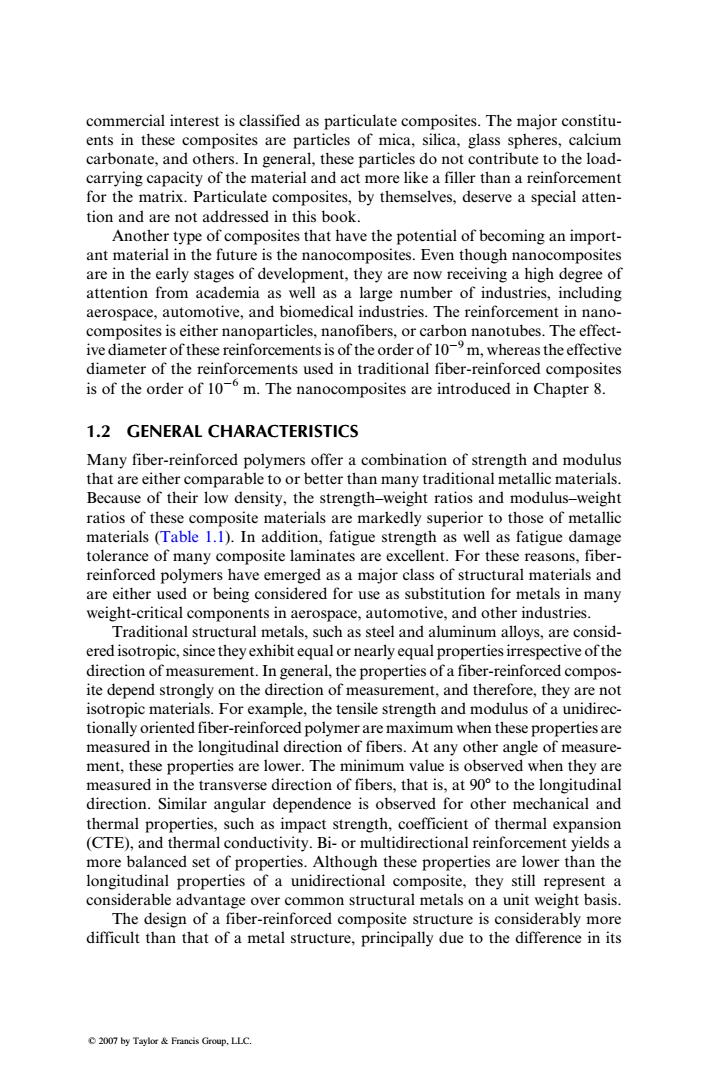正在加载图片...

commercial interest is classified as particulate composites.The major constitu- ents in these composites are particles of mica,silica,glass spheres,calcium carbonate,and others.In general,these particles do not contribute to the load- carrying capacity of the material and act more like a filler than a reinforcement for the matrix.Particulate composites,by themselves,deserve a special atten- tion and are not addressed in this book. Another type of composites that have the potential of becoming an import- ant material in the future is the nanocomposites.Even though nanocomposites are in the early stages of development,they are now receiving a high degree of attention from academia as well as a large number of industries,including aerospace,automotive,and biomedical industries.The reinforcement in nano- composites is either nanoparticles,nanofibers,or carbon nanotubes.The effect- ive diameter of these reinforcements is of the order of 10m,whereas the effective diameter of the reinforcements used in traditional fiber-reinforced composites is of the order of 10m.The nanocomposites are introduced in Chapter 8. 1.2 GENERAL CHARACTERISTICS Many fiber-reinforced polymers offer a combination of strength and modulus that are either comparable to or better than many traditional metallic materials. Because of their low density,the strength-weight ratios and modulus-weight ratios of these composite materials are markedly superior to those of metallic materials (Table 1.1).In addition,fatigue strength as well as fatigue damage tolerance of many composite laminates are excellent.For these reasons,fiber- reinforced polymers have emerged as a major class of structural materials and are either used or being considered for use as substitution for metals in many weight-critical components in aerospace,automotive,and other industries. Traditional structural metals,such as steel and aluminum alloys,are consid- ered isotropic,since they exhibit equal or nearly equal properties irrespective of the direction of measurement.In general,the properties of a fiber-reinforced compos- ite depend strongly on the direction of measurement,and therefore,they are not isotropic materials.For example,the tensile strength and modulus of a unidirec- tionally oriented fiber-reinforced polymer are maximum when these properties are measured in the longitudinal direction of fibers.At any other angle of measure- ment,these properties are lower.The minimum value is observed when they are measured in the transverse direction of fibers,that is,at 90 to the longitudinal direction.Similar angular dependence is observed for other mechanical and thermal properties,such as impact strength,coefficient of thermal expansion (CTE),and thermal conductivity.Bi-or multidirectional reinforcement yields a more balanced set of properties.Although these properties are lower than the longitudinal properties of a unidirectional composite,they still represent a considerable advantage over common structural metals on a unit weight basis. The design of a fiber-reinforced composite structure is considerably more difficult than that of a metal structure,principally due to the difference in its 2007 by Taylor Francis Group,LLC.commercial interest is classified as particulate composites. The major constituents in these composites are particles of mica, silica, glass spheres, calcium carbonate, and others. In general, these particles do not contribute to the loadcarrying capacity of the material and act more like a filler than a reinforcement for the matrix. Particulate composites, by themselves, deserve a special attention and are not addressed in this book. Another type of composites that have the potential of becoming an important material in the future is the nanocomposites. Even though nanocomposites are in the early stages of development, they are now receiving a high degree of attention from academia as well as a large number of industries, including aerospace, automotive, and biomedical industries. The reinforcement in nanocomposites is either nanoparticles, nanofibers, or carbon nanotubes. The effective diameter of these reinforcementsis of the order of 109 m, whereasthe effective diameter of the reinforcements used in traditional fiber-reinforced composites is of the order of 106 m. The nanocomposites are introduced in Chapter 8. 1.2 GENERAL CHARACTERISTICS Many fiber-reinforced polymers offer a combination of strength and modulus that are either comparable to or better than many traditional metallic materials. Because of their low density, the strength–weight ratios and modulus–weight ratios of these composite materials are markedly superior to those of metallic materials (Table 1.1). In addition, fatigue strength as well as fatigue damage tolerance of many composite laminates are excellent. For these reasons, fiberreinforced polymers have emerged as a major class of structural materials and are either used or being considered for use as substitution for metals in many weight-critical components in aerospace, automotive, and other industries. Traditional structural metals, such as steel and aluminum alloys, are considered isotropic, since they exhibit equal or nearly equal properties irrespective of the direction of measurement. In general, the properties of a fiber-reinforced composite depend strongly on the direction of measurement, and therefore, they are not isotropic materials. For example, the tensile strength and modulus of a unidirectionally oriented fiber-reinforced polymer are maximum when these properties are measured in the longitudinal direction of fibers. At any other angle of measurement, these properties are lower. The minimum value is observed when they are measured in the transverse direction of fibers, that is, at 908 to the longitudinal direction. Similar angular dependence is observed for other mechanical and thermal properties, such as impact strength, coefficient of thermal expansion (CTE), and thermal conductivity. Bi- or multidirectional reinforcement yields a more balanced set of properties. Although these properties are lower than the longitudinal properties of a unidirectional composite, they still represent a considerable advantage over common structural metals on a unit weight basis. The design of a fiber-reinforced composite structure is considerably more difficult than that of a metal structure, principally due to the difference in its 2007 by Taylor & Francis Group, LLC